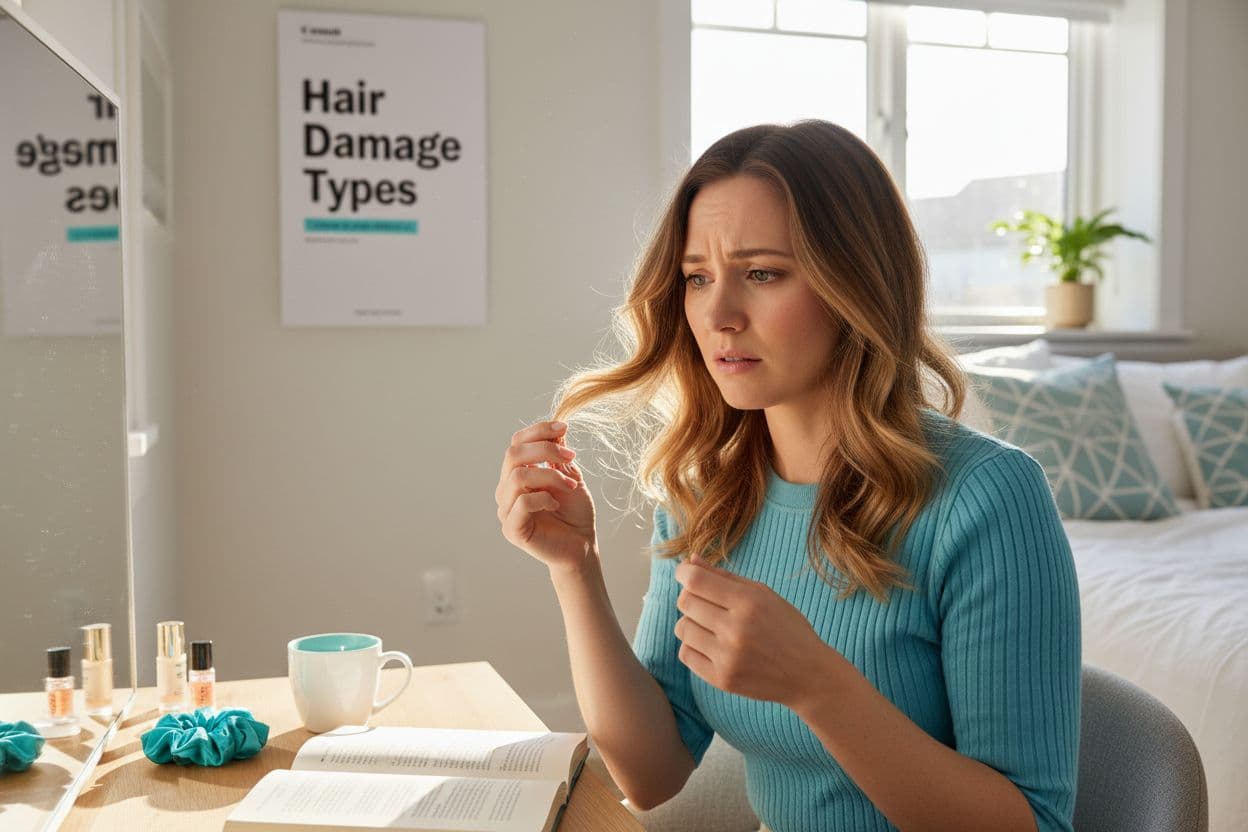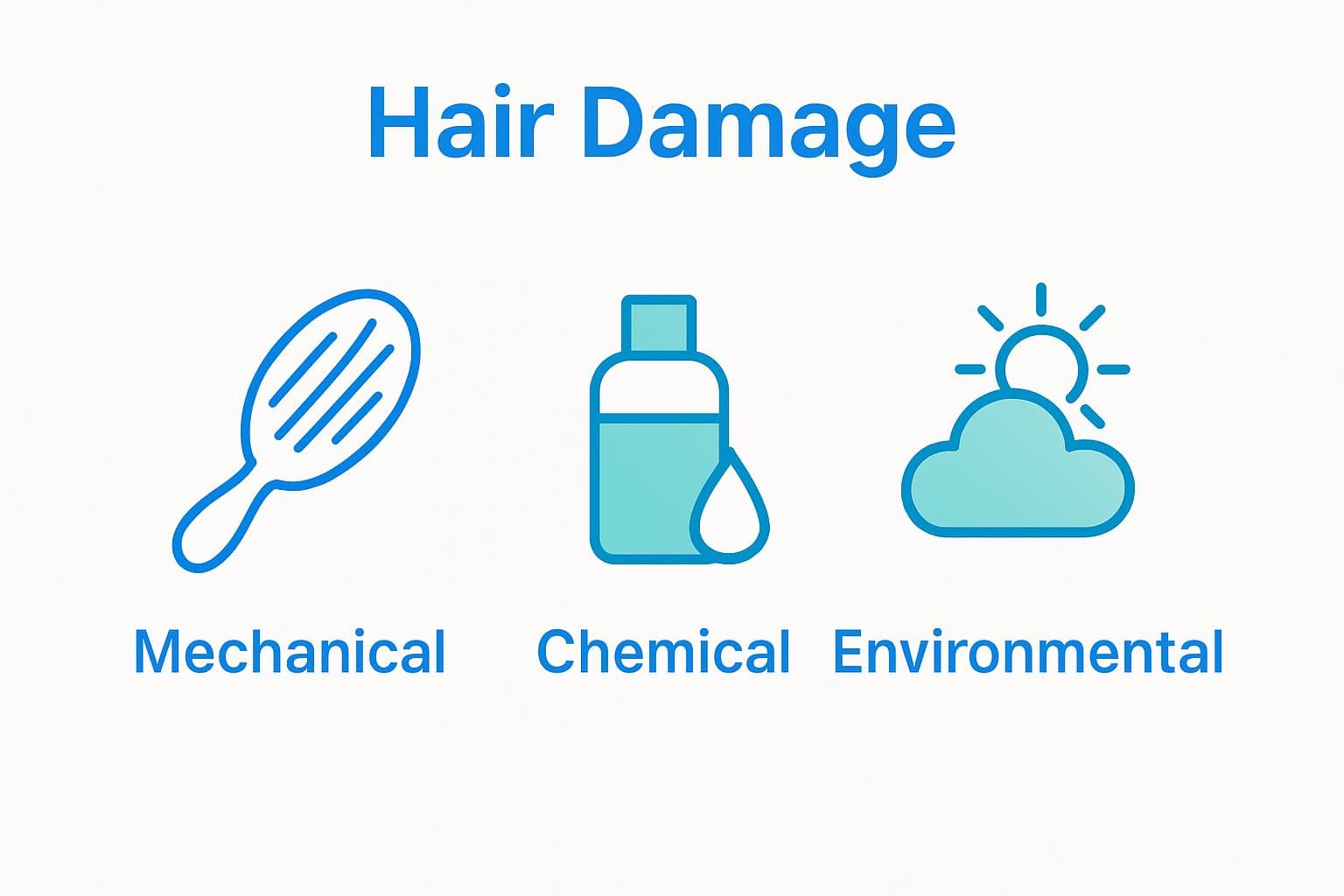Blog
Learning Materials
Understanding Hair Damage Types: A Complete Guide
Updated: October 14, 2025

Millions struggle with breakage, dryness, and split ends but few know why their hair changes so suddenly. Over 70 percent of people experience some form of hair damage due to daily habits and environmental stress, yet most only notice the signs when it is already too late. Surprisingly, your biggest threat might not be your shampoo or the heat from your blow dryer but the tiny, almost invisible changes happening inside each strand that quietly rewrite the quality of your hair for good.
Table of Contents
- What Are Hair Damage Types And Their Effects?
- Why Understanding Hair Damage Types Matters For Your Hair Health
- How Hair Damage Occurs: The Mechanism Behind It
- Identifying Different Hair Damage Types: Signs And Symptoms
- Key Concepts In Managing And Preventing Hair Damage
Quick Summary
| Takeaway | Explanation |
|---|---|
| Recognize hair damage types early | Identifying mechanical, chemical, and environmental damage helps prevent long-term problems. |
| Implement targeted repair strategies | Customize interventions based on specific damage types to optimize hair health. |
| Practice proactive hair care | Daily maintenance routines can significantly enhance hair strength and resilience. |
| Address nutritional factors | Consuming a balanced diet supports hair health and prevents degradation. |
| Limit environmental exposure | Using UV protection and reducing harsh treatments safeguard against hair damage. |
What Are Hair Damage Types and Their Effects?
Hair damage represents a complex issue affecting millions of people worldwide, characterized by structural changes that compromise hair health and appearance. Medical research from the American Academy of Dermatology reveals that hair damage occurs through multiple mechanisms, impacting different layers of hair strands.
Understanding Hair Structure and Vulnerability
To comprehend hair damage types, we must first recognize hair's intricate structure. Hair consists of three primary layers: the cuticle (outer protective layer), cortex (middle layer containing keratin), and medulla (inner core). When external factors compromise these layers, various damage types emerge.
Primary Categories of Hair Damage
Hair damage manifests through distinct categories, each affecting hair structure differently:

- Mechanical Damage: Caused by harsh styling practices like excessive brushing, tight hairstyles, and heat styling tools
- Chemical Damage: Results from repeated chemical treatments such as bleaching, coloring, and perming
- Environmental Damage: Triggered by UV exposure, pollution, humidity, and extreme temperature fluctuations
Each damage type progressively weakens hair's internal protein structure, leading to breakage, split ends, and reduced hair quality.
Below is a comparison table summarizing the key types of hair damage described in the article, along with their causes and main signs to help with identification.
| Damage Type | Main Causes | Key Signs & Symptoms |
|---|---|---|
| Mechanical Damage | Excessive brushing, tight hairstyles, heat | Increased breakage, split ends, rough feel |
| Chemical Damage | Bleaching, coloring, perming | Dryness, color fading, stringy appearance |
| Environmental Damage | UV exposure, pollution, humidity, temperature | Brittleness, frizz, discoloration |
| Detailed studies from the National Institutes of Health indicate that prolonged exposure to these damaging factors can permanently alter hair's natural growth patterns. |
Interested in developing a comprehensive hair care strategy? Check out our guide to maintaining healthy hair to protect and restore your hair's natural strength and resilience.
Why Understanding Hair Damage Types Matters for Your Hair Health
Knowing the specific types of hair damage is not merely an academic exercise but a critical strategy for maintaining long-term hair health and preventing irreversible structural breakdown. Clinical research from the Journal of Cosmetic Dermatology emphasizes that targeted interventions based on precise damage assessment can significantly improve hair restoration outcomes.
The Long-Term Consequences of Unaddressed Hair Damage
Ignoring hair damage is akin to overlooking structural weaknesses in a building. Each unaddressed damage type progressively compromises hair's fundamental integrity, leading to cumulative and potentially permanent changes. These changes extend beyond aesthetic concerns, impacting hair's fundamental growth mechanisms and overall scalp health.
Strategic Approaches to Hair Damage Prevention
Effective hair care requires a nuanced understanding of damage mechanisms. Recognizing specific damage types enables individuals to develop personalized protection strategies:
- Targeted Treatment: Select interventions specific to your unique damage profile
- Preventive Maintenance: Implement protective measures before significant structural degradation occurs
- Customized Product Selection: Choose hair care products aligned with your specific damage type
Beyond individual care, understanding hair damage supports broader scientific comprehension of hair biology. Explore our advanced hair treatment solutions to leverage cutting-edge research in hair health management.
Ultimately, knowledge transforms hair care from reactive management to proactive preservation, empowering individuals to make informed decisions about their hair's long-term health and appearance.
How Hair Damage Occurs: The Mechanism Behind It
Hair damage is a progressive process involving complex interactions between external stressors and hair's intricate structural components. Dermatological research from the National Institutes of Health reveals that hair damage mechanisms are multifaceted, targeting different layers of hair strands simultaneously.
Cuticle Layer: The First Line of Defense
The cuticle represents hair's protective armor, consisting of overlapping keratin scales that shield the inner hair structure. When these protective scales become compromised, hair becomes vulnerable to deeper structural damage. Repeated exposure to harsh treatments gradually erodes this protective barrier, creating microscopic cracks and weakening hair's overall integrity.
Biochemical Pathways of Hair Degradation
Hair damage occurs through several interconnected mechanisms:
- Protein Denaturation: Chemical and thermal treatments break down keratin protein structures
- Lipid Disruption: External stressors remove natural protective oils, increasing hair porosity
- Oxidative Stress: Free radicals generated by environmental factors accelerate molecular breakdown
These processes transform hair from a resilient, flexible fiber into a brittle, fragile strand prone to breakage. The cumulative effect creates progressive structural changes that cannot be fully reversed through conventional treatments.
Explore our comprehensive hair mask solutions to understand how targeted interventions can mitigate and slow down these damaging processes. Understanding these intricate mechanisms empowers individuals to make informed decisions about hair care and maintenance.
Identifying Different Hair Damage Types: Signs and Symptoms
Recognizing hair damage early prevents long-term structural degradation. Clinical research from the American Academy of Dermatology highlights the importance of understanding subtle indicators that signal different damage types, enabling timely intervention and preservation of hair health.
Visual and Textural Indicators
Hair damage manifests through distinct physical transformations that go beyond surface-level appearance. Professional hair experts look for specific textural changes, color variations, and structural anomalies that indicate underlying damage. Microscopic examination reveals crucial insights, showing how external stressors progressively compromise hair's intrinsic integrity.
Comprehensive Damage Assessment Markers
Different hair damage types present unique diagnostic markers that trained professionals assess:
-
Mechanical Damage Indicators:
- Increased breakage near hair ends
- Rough, uneven texture
- Visible split ends
- Reduced hair elasticity
-
Chemical Damage Symptoms:
- Excessive dryness
- Unexpected color fading
- Stringy, lifeless appearance
- Increased porosity
-
Environmental Damage Signs:
- Brittle strand structure
- Unusual frizz patterns
- Discoloration
- Weakened hair shaft
Discover targeted solutions for managing hair fall and learn how strategic interventions can mitigate progressive damage. Understanding these nuanced indicators empowers individuals to develop personalized hair care strategies that address specific damage mechanisms.
Key Concepts in Managing and Preventing Hair Damage
Proactive hair care transcends reactive treatments. Research from the National Institutes of Health emphasizes that comprehensive hair damage management requires understanding complex interactions between external stressors and hair's biological structure.
Holistic Protection Strategies
Effective hair damage prevention demands a multifaceted approach that addresses nutritional, environmental, and mechanical factors. Professional trichologists recognize that protecting hair involves more than superficial treatments, requiring deep understanding of hair's intrinsic vulnerability and adaptive mechanisms.
Comprehensive Damage Mitigation Framework
Successful hair damage management encompasses several critical intervention strategies:
-
Protective Techniques:
- Minimize heat styling frequency
- Use low temperature settings on styling tools
- Implement heat protection products
- Choose gentle hair accessories
-
Nutritional Support:
- Consume protein-rich diet
- Maintain adequate hydration
- Include omega-3 fatty acids
- Consider targeted supplementation
-
Environmental Defense:
- Use UV protective hair products
- Limit sun exposure
- Wear protective headwear
- Reduce chlorine and saltwater contact
Explore expert tips for stronger hair and skin growth to develop a comprehensive understanding of holistic hair health management. Understanding these interconnected principles transforms hair care from a reactive process to a proactive lifestyle approach.
This table organizes the main intervention strategies for managing and preventing hair damage, providing a clear overview of approaches to holistic hair protection.
| Strategy Category | Specific Actions |
|---|---|
| Protective Techniques | Limit heat styling, use lower temperatures, heat protectants, gentle accessories |
| Nutritional Support | Protein-rich diet, hydration, omega-3s, targeted supplements |
| Environmental Defense | UV protective products, limit sun, protective wear, reduce chlorine/saltwater |

Take Control of Hair Damage With Smart, Personalized Solutions
You have learned how mechanical, chemical, and environmental factors can silently weaken your hair. If you are noticing breakage, increased dryness, or loss of shine, now is the time to act. The longer you wait, the more challenging it becomes to restore healthy hair structure. Getting a truly personalized solution matters—generic advice cannot address your unique needs.

MyHair.ai uses advanced AI technology to analyze your specific hair damage and deliver tailored recommendations. Upload a scan, track progress, and see science-backed product suggestions that precisely fit your situation. Turn knowledge into action and protect your hair’s future. Visit our easy-to-use platform at MyHair.ai to get started, or try our specialized healthy hair care routine guide for practical steps you can use immediately. Discover how modern AI tools and expert advice can change the course of your hair health today.
Frequently Asked Questions
What are the different types of hair damage?
Hair damage primarily falls into three categories: mechanical damage, chemical damage, and environmental damage. To identify specific issues, assess your hair's texture, dryness, and overall strength.
How can I recognize mechanical hair damage?
Mechanical hair damage often presents as increased breakage, rough texture, and visible split ends. To address this, minimize excessive brushing and tight hairstyles, and avoid using heat styling tools too frequently.
What steps can I take to prevent chemical hair damage?
To prevent chemical damage, limit the frequency of harsh treatments like bleaching, coloring, and perming. Implement a routine that includes deep conditioning treatments at least once a week to strengthen your hair's natural structure.
How does environmental damage affect my hair, and how can I protect it?
Environmental damage can lead to brittleness, discoloration, and unusual frizz patterns due to UV exposure and pollution. Protect your hair by using UV protective products, wearing hats in the sun, and cleansing after swimming in chlorinated water.
What are the signs of hair damage to look out for?
Common signs of hair damage include excessive dryness, unexpected color fading, and reduced elasticity. Regularly assess your hair for these symptoms and consider adjusting your hair care routine if you notice any changes.
Why is it important to understand hair damage types for hair care?
Understanding hair damage types allows you to tailor your hair care strategy effectively, ensuring that you address specific needs. Start by identifying the type of damage you have, and then select treatments that are aligned to repair and protect your hair.